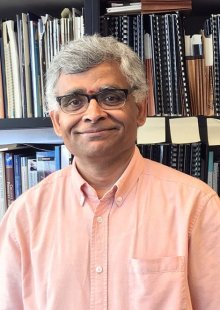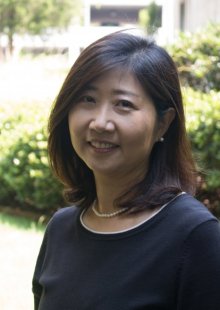
By Yvonne Medina
Sundaresan Jayaraman and Sungmee Park insist that, “Materials, innovation, technology, and computing should enhance the quality of life of people.”
Their research, which lies at the convergence of textiles and computing, has focused on saving the lives of soldiers on the battlefield, infants prone to sudden infant death syndrome (SIDS), hospital patients susceptible to developing pressure injuries, and designing the next generation of respiratory protective devices to prevent inhalation hazards.
They work in the School of Materials Science and Engineering, where Jayaraman is a professor and Park is a principal research scientist. And in their lab at Georgia Tech, they have reimagined how clothing and technology can merge, establishing a whole new field of smart textiles.
The Whole Equation
Growing up in India, Jayaraman’s parents figured that people would always need clothing, so they told him he would always have a job if he pursued a degree in textile engineering. He said he feels fortunate to have been able to pursue this sought-after discipline because he was one of only 60 students in India who earned a degree in textile engineering the year he graduated. In the U.S., he worked with the individuals who created the world’s first spreadsheet software, VisiCalc. Developed at Software Arts, the technology eventually evolved into Lotus 1-2-3 and then into Microsoft Excel. Software Arts funded his fellowship when he pursued his Ph.D. with the late Professor Milos Konopasek, the creator of QAS and TK!Solver, the world’s first equation-solving program.
As part of his doctoral research, Jayaraman was involved in the development of the commercially available TK!Solver program. While he does not derive any royalties from the program, that work laid the foundation for his research with his students at Tech at the convergence of textiles and computing. Jayaraman’s research has pushed clothing into the digital era, taking it beyond mere aesthetics and protection from the elements and into the realm of smart technology. Jayaraman and Park asked themselves, “How do we make clothing more intelligent? How do we bring everyday fabric into the digital era?” They began to integrate conductive materials and sensors into fabrics and make interconnections to route the information through the fabric, creating the world’s first wearable motherboard. This innovation gave birth to the field of smart textiles in 1996.
The first Smart Shirt wearable motherboard that Park created is now part of the archives of the Smithsonian’s National Museum of American History. Park’s background bridges form, function, art and engineering with a master’s degree in fine arts in addition to engineering degrees. She said it’s critical to produce products that are both technologically effective and aesthetically pleasing. “Sungmee brings both the left- and right-brain thinking to the whole equation,” Jayaraman said.
Smart Textiles
“The field of smart textiles was born because we were trying to save the lives of soldiers in battle and relay information to medics and other military personnel in real-time,” Jayaraman said. “We were able to create a fabric-based motherboard in which we can put sensors wherever we want and route the information.” This technology can be used to identify where a soldier on the battlefield has been shot; monitor vital signs such as heart rate, electrocardiogram, and body temperature; and transmit it to the medic to save lives during the “golden hour," a critical window of time in trauma medicine.
The Smart Shirt also can be used to monitor the vital signs of individuals in non-combat settings, babies prone to SIDS, and carbon monoxide levels, among other applications. This technology could also eliminate the need for hospital patients to be hooked up with wires to devices for monitoring vital signs, giving patients much more freedom to move.
Another medical issue is pressure injuries. Pressure injuries, also known as bedsores, occur when people lie in bed or sit for a long period of time, especially for those in wheelchairs. It is reported that 60,000 people die every year from pressure injuries and studies have shown that we spend $26.8 billion annually treating wounds from pressure injuries in hospitals. If a patient has sustained a spinal cord injury, for example, they cannot feel any sensation and are more prone to pressure injuries. Jayaraman and Park’s technology has been integrated into bedsheets to monitor pressure as well as moisture, another factor that leads to pressure injuries. Their sensors can alert a nurse if a patient needs to be moved.
They also have built an automatic intervention system into a wheelchair to relieve moisture and pressure in real-time to prevent pressure injuries in individuals with limited mobility. They have received the National Academy of Medicine’s Catalyst Award in the Healthy Longevity Global Grand Challenge for further development of the technology.
More recently, Jayaraman’s group created technology that scans a person’s face to create a respiratory protective device (RPD) that is customized to fit the individual’s facial profile. These customizable RPDs also monitor the pressure around the contact surface between the device and the wearer’s face using a fabric-based sensor network to alert the user when the face seal is compromised. It’s a project supported by the U.S. Centers for Disease Control and Prevention. “This technology is the first step towards ensuring equitable protection for all,” Jayaraman said, since masks and respirators are manufactured in a limited number of sizes, making it hard to fit the diverse population in the U.S.
Making a Difference
Jayaraman and Park are passionate about encouraging students to study materials science and engineering. “Materials science is at the center of everyday life,” Park said, noting that materials science is connected to everything, from the food we eat to the makeup we wear and the medicines we take. Jayaraman likened materials science to ice cream flavors: students get a solid foundation in math, physics, and chemistry, but then they can choose whatever toppings they want — biomaterials, functional materials, electronics, polymers, textiles, metals, and ceramics, for example. The opportunities to innovate and find a niche that matches your interests are endless.
“Materials science is fascinating for anybody who wants to make a difference,” Jayaraman said.